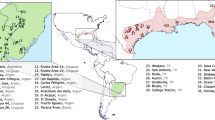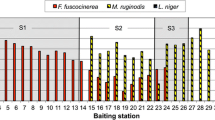Abstract
In recent years, highly invasive ant species successively invaded warm regions of Asia. In Japan, the Argentine ant, Linepithema humile, has become established in several coastal regions. This species forms unusual social organizations called supercolonies consisting of numerous mutually non-aggressive nests. We studied the behavioral relationships, similarity of cuticular hydrocarbon profiles (nestmate recognition cue), and genetic relationships among the introduced Argentine ant populations of Japan. The Japanese populations were divided into four behaviorally, chemically, and genetically distinct supercolonies, which may have derived from independent source populations. The result represents the recent trend of increasing invasions of invasive ants to Asia. The discontinuous distribution of one supercolony throughout most of the Japanese range suggests rapid expansion of the supercolony via human-mediated jump dispersal. Meanwhile, localization of the other three supercolonies in Kobe Port provides the first evidence for multiple invasions of distinct supercolonies into a base for international trade.




Similar content being viewed by others
References
Bond W, Slingsby P (1984) Collapse of an ant-plant mutualism: the Argentine ant (Iridomyrmex humilis) and myrmecochorous Proteaceae. Ecology 65:1031–1037. doi:10.2307/1938311
Buczkowski G, Vargo EL, Silverman J (2004) The diminutive supercolony: the Argentine ants of the southeastern United States. Mol Ecol 13:2235–2242. doi:10.1111/j.1365-294X.2004.02261.x
Buczkowski G, Kumar R, Suib SL, Silverman J (2005) Diet-related modification of cuticular hydrocarbon profiles of the Argentine ant, Linepithema humile, diminishes intercolony aggression. J Chem Ecol 31:829–843. doi:10.1007/s10886-005-3547-7
Corin SE, Lester PJ, Abbott KL, Ritchie PA (2007a) Inferring historical introduction pathways with mitochondrial DNA: the case of introduced Argentine ants (Linepithema humile) into New Zealand. Divers Distrib 13:510–518
Corin SE, Abbott KA, Ritchie PA, Lester PJ (2007b) Large scale unicoloniality: the population and colony structure of the invasive Argentine ant (Linepithema humile) in New Zealand. Insectes Soc 54:275–282. doi:10.1007/s00040-007-0942-9
de Biseau J-C, Passera L, Daloze D, Aron S (2004) Ovarian activity correlates with extreme changes in cuticular hydrocarbon profile in the highly polygynous ant, Linepithema humile. J Insect Physiol 50:585–593. doi:10.1016/j.jinsphys.2004.04.005
Giraud T, Pedersen JS, Keller L (2002) Evolution of supercolonies: the Argentine ants of southern Europe. Proc Natl Acad Sci USA 99:6075–6079. doi:10.1073/pnas.092694199
Greene MJ, Gordon DM (2007) Structural complexity of chemical recognition cues affects the perception of group membership in the ants Linepithema humile and Aphaenogaster cookerelli. J Exp Biol 210:897–905. doi:10.1242/jeb.02706
Heller NE (2004) Colony structure in introduced and native populations of the invasive Argentine ant, Linepithema humile. Insectes Soc 51:378–386. doi:10.1007/s00040-004-0770-0
Holway DA (1999) Competitive mechanism underlying the displacement of native ants by the invasive Argentine ant. Ecology 80:238–251
Holway DA, Suarez AV, Case TJ (1998) Loss of intraspecific aggression in the success of a widespread invasive social insect. Science 282:949–952. doi:10.1126/science.282.5390.949
Holway DA, Lach L, Suarez AV, Tsutsui ND, Case TJ (2002) Causes and consequences of ant invasions. Annu Rev Ecol Syst 33:181–233. doi:10.1146/annurev.ecolsys.33.010802.150444
Jaquiéry J, Vogel V, Keller L (2005) Multilevel genetic analyses of two supercolonies of the Argentine ant, Linepithema humile. Mol Ecol 14:589–598. doi:10.1111/j.1365-294X.2005.02433.x
Kreiger MJB, Keller L (1999) Low polymorphism at 19 microsatellite loci in a French population of Argentine ants (Linepithema humile). Mol Ecol 8:1078–1080. doi:10.1046/j.1365-294X.1999.00655_3.x
Lewis PO, Zaykin D (1998) Genetic data analysis software. Computer program for the analysis of allelic data. Version 1.0. http://alleyn.eeb.ucon.edu/gda/
Liang D, Silverman J (2000) “You are what you eat”: diet modifies cuticular hydrocarbons and nestmate recognition in the Argentine ant, Linepithema humile. Naturwissenschaften 87:412–416. doi:10.1007/s001140050752
Liang D, Blomquist GJ, Silverman J (2001) Hydrocarbon-released nestmate aggression in the Argentine ant, Linepithema humile, following encounters with insect prey. Comp Biochem Physiol Part B 129:871–882. doi:10.1016/S1096-4959(01)00404-3
Okaue M, Yamamoto K, Touyama Y, Kameyama T, Terayama M, Sugiyama T, Murakami K, Ito F (2007) Distribution of the Argentine ant, Linepithema humile, along the Seto Inland Sea, western Japan: result of surveys in 2003–2005. Entomol Sci 10:337–342
Pedersen JS, Krieger MJB, Vogel V, Giraud T, Keller L (2006) Native supercolonies of unrelated individuals in the invasive Argentine ant. Evol Int J Org Evol 60:782–791
R Development Core Team (2007) R: a language and environment for statistical computing. R Foundation for Statistical Computing, Vienna
Radchenko A (2005) Monographic revision of the ants (Hymenoptera: Formicidae) of North Korea. Ann Zool 55:127–221
Raymond M, Rousset F (1995) GENEPOP (version 1.2): a population genetic software for exact test and ecumenicism. J Hered 86:248–249
Rowles AD, O’Dowd DJ (2007) Interference competition by Argentine ants displaces native ants: implications for biotic resistance to invasion. Biol Invasions 9:73–85. doi:10.1007/s10530-006-9009-5
Sambrook J, Fritsch EF, Maniatis T (1989) Molecular cloning: a laboratory manual, 2nd edn. Cold Spring Harbor Laboratory Press, Woodbury
Shoemaker DD, DeHeer CJ, Krieger MJB, Ross KG (2006) Population genetics of the invasive fire ant Solenopsis invicta (Hymenoptera: Formicidae) in the United States. Ann Entomol Soc Am 99:1213–1233. doi:10.1603/0013-8746(2006)99[1213:PGOTIF]2.0.CO;2
Silverman J, Brightwell RJ (2008) The Argentine ant: challenges in managing an invasive unicolonial pest. Annu Rev Entomol 53:231–252. doi:10.1146/annurev.ento.53.103106.093450
Silverman J, Liang D (2001) Colony disassociation following diet partitioning in a unicolonial ant. Naturwissenschaften 88:73–77. doi:10.1007/s001140000198
Sneath PHA, Sokal RR (1973) Numerical taxonomy. Freeman, San Francisco
Suarez AV, Tsutsui ND, Holway DA, Case TJ (1999) Behavioral and genetic differentiation between native and introduced populations of the Argentine ant. Biol Invasions 1:43–53. doi:10.1023/A:1010038413690
Suarez AV, Holway DA, Case TJ (2001) Patterns of spread in biological invasions dominated by long-distance jump dispersal: insights from Argentine ants. Proc Natl Acad Sci USA 98:1095–1100. doi:10.1073/pnas.98.3.1095
Suarez AV, Holway DA, Liang D, Tsutsui ND, Case TJ (2002) Spatiotemporal patterns of intraspecific aggression in the invasive Argentine ant. Anim Behav 64:697–708. doi:10.1006/anbe.2002.4011
Sugiyama T (2000) Invasion of Argentine ant, Linepithema humile, into Hiroshima Prefecture, Japan. Jpn J Appl Entomol Zool 44:127–129. doi:10.1303/jjaez.2000.127
Sunamura E, Nishisue K, Terayama M, Tatsuki S (2007) Invasion of four Argentine ant supercolonies into Kobe Port, Japan: their distributions and effects on indigenous ants (Hymenoptera: Formicidae). Sociobiology 50:659–674
Thomas ML, Payne-Makrisâ CM, Suarez AV, Tsutsui ND, Holway DA (2006) When supercolonies collide: territorial aggression in an invasive and unicolonial social insect. Mol Ecol 15:4303–4315. doi:10.1111/j.1365-294X.2006.03038.x
Torres CW, Brandt M, Tsutsui ND (2007) The role of cuticular hydrocarbons as chemical cues for nestmate recognition in the invasive Argentine ant (Linepithema humile). Insectes Soc 54:329–333. doi:10.1007/s00040-007-0954-5
Touyama Y, Ogata K, Sugiyama T (2003) The Argentine ant, Linepithema humile, in Japan: assessment of impact on species diversity of ant communities in urban environments. Entomol Sci 6:57–62. doi:10.1046/j.1343-8786.2003.00008.x
Tsutsui ND, Suarez AV, Holway DA, Case TJ (2000) Reduced genetic variation and the success of an invasive species. Proc Natl Acad Sci USA 97:5948–5953. doi:10.1073/pnas.100110397
Tsutsui ND, Suarez AV, Holway DA, Case TJ (2001) Relationships among native and introduced populations of the Argentine ant (Linepithema humile) and the source of introduced populations. Mol Ecol 10:2151–2161. doi:10.1046/j.0962-1083.2001.01363.x
Wetterer JK, Wetterer AL (2006) A disjunct Argentine ant metacolony in Macaronesia and southwestern Europe. Biol Invasions 8:1123–1129. doi:10.1007/s10530-005-8641-9
Wright S (1951) The genetical structure of populations. Ann Eugen 15:323–354
Yang CC, Shoemaker DD, Wu WJ, Shih CJ (2008) Population genetic structure of the red imported fire ant, Solenopsis invicta, in Taiwan. Insectes Soc 55:54–65. doi:10.1007/s00040-007-0969-y
Zhang R, Li Y, Liu N, Porter SD (2007) An overview of the red imported fire ant (Hymenoptera: Formicidae) in mainland China. Fla Entomol 90:723–731. doi:10.1653/0015-4040(2007)90[723:AOOTRI]2.0.CO;2
Acknowledgments
We would like to express our sincere thanks to Yukio Ishikawa and Toshiharu Akino for their enormous help in the chemical analyses, Fuminori Ito for providing an early draft of Okaue et al. (2007), Sugihiko Hoshizaki and Ryo Nakano for thoughtful advice, Hironori Sakamoto and Shun Suzuki for encouragement, and two anonymous referees for valuable comments on the manuscript.
Author information
Authors and Affiliations
Corresponding author
Rights and permissions
About this article
Cite this article
Sunamura, E., Hatsumi, S., Karino, S. et al. Four mutually incompatible Argentine ant supercolonies in Japan: inferring invasion history of introduced Argentine ants from their social structure. Biol Invasions 11, 2329–2339 (2009). https://doi.org/10.1007/s10530-008-9419-7
Received:
Accepted:
Published:
Issue Date:
DOI: https://doi.org/10.1007/s10530-008-9419-7




